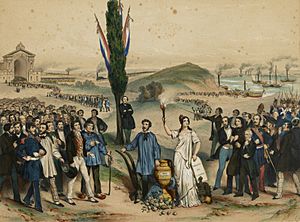Universal manhood suffrage facts for kids
Universal manhood suffrage is a fancy way of saying that all adult men in a country can vote. It doesn't matter how much money they make, what property they own, their religion, or their race. Everyone gets one vote.
Contents
History of Voting Rights for Men
Long ago, not everyone could vote. Often, only men who owned land or had a lot of money were allowed to cast a ballot.
Voting in France
In 1789, a big change happened in France called the French Revolution. During this time, the country created a document called the Declaration of the Rights of Man and of the Citizen. For a short time in 1792, all men in France were allowed to vote for their leaders. However, this right was taken away in 1795.
Later, after another big event called the French Revolution of 1848, all men in France were once again given the right to vote. This was a very important moment for the idea of democracy.
Voting in the United States
In the United States, during the 1820s to 1850s, more and more white men gained the right to vote. This period is sometimes called Jacksonian democracy. By 1856, most states allowed all white men to vote, even if they were poor.
However, many African-American men were still not allowed to vote. After the American Civil War, the Fifteenth Amendment to the United States Constitution was added in 1870. This amendment said that a person's right to vote could not be denied because of their race. Even with this law, many African-American men were still stopped from voting in some places for nearly 100 more years. It wasn't until the Civil Rights Movement and the Voting Rights Act of 1965 that these rights were fully protected.
From Men Only to Everyone
As time went on, women also started to gain the right to vote in the late 1800s and early 1900s. When both men and women can vote, it's called universal suffrage. This means that almost all adult citizens, regardless of gender, race, or wealth, have the right to vote.
See also
 In Spanish: Sufragio masculino para niños
In Spanish: Sufragio masculino para niños


